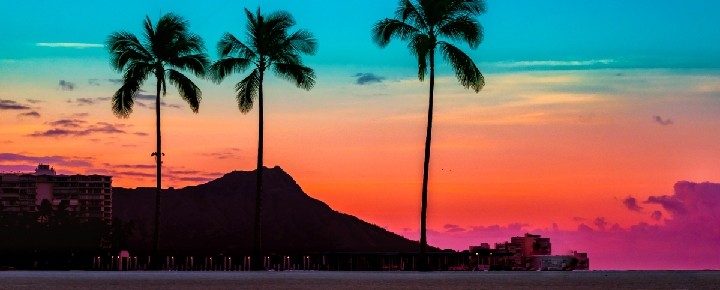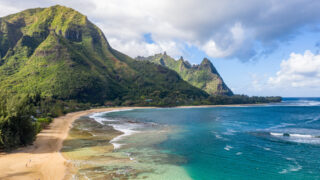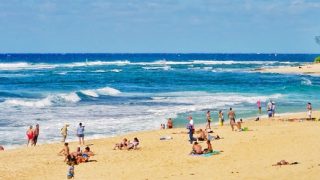Without a doubt, this has been the oddest year we can ever remember in Hawaii travel. At least for those of us who call Hawaii home. We suspect it may have been the same for Hawaii visitors too. If you joined us after Covid, let us know what differences, if any, you noticed.
In the end, Hawaii seems to be adjusting to visitors returning. That’s true even as the neighbor islands, where international travel doesn’t play much of a role, have seen more visitors than ever before.
The shocking juxtaposition of tourists, then no tourists, then tourists, threw everything awry.
We went from 2019, which was record-breaking, to the Covid downturn in early 2020, where everything crashed. Then, as had happened a decade earlier, there were no more tourists. And that was odd; very odd.
Your editors remember Hanalei looking like a ghost town on a summer day with no traffic, businesses closed, and the beach empty. It felt eerie and also concerning about what the future would be.
Then starting earlier this year, Hawaii tourism rebounded with a naively unexpected vengeance. Clearly, Hawaii travel wasn’t ready and chaos related to the lack of people to do the tourism jobs, from airlines to hotels to restaurants, ensued. They had been fired, they had quit, the jobs were gone, and in the end, not too many people wanted these service positions any longer.
Clearly, the world had changed. And last but not least, our heads were left spinning with so many rental cars on the road again.
Tourists and residents seem to be playing together better once again.
As tourism returned, a discernable shift in attitude came too. Not just in Hawaii either. While most visitors are both kind and considerate, a change for the worse seemed to occur. And you tell us in your comments that was true.
“Revenge travel” became an attitude of entitlement for some Hawaii visitors. When travelers are over-indulged, demanding, and have higher than possible to fulfill expectations for Hawaii. Some travelers didn’t get the premium service they expected, especially as prices escalated, and acted out. We can tell you as residents that when you see this, it’s easy to start to think that entitled Hawaii tourists are more pervasive than they are.
Also, the way news works, it’s always easier to find the bad than to see the good. So even though bad behavior was the exception, it dominated the news. That included visitor trespassing incidents and misconduct arrests, among other things.
Tourism is complicated and controversial in Hawaii and similar tourism-centric locations.
We know there had been growing unrest for years as Hawaii tourism continued to grow and grow without bounds and much-needed infrastructure, planning or effective governance.
There has been, to be honest, growing discontent with ever-increasing Hawaii tourism that’s been ongoing for years. Hawaii is being overrun with tourism, that is without question. And Hawaii doesn’t have either good infrastructure or planning skills and never has. These are severe shortcomings for a state so focused on travel.
The need for better tourism management, rather than tourism development, has never been so clear. That’s true at every level, from community organizations to government. It is hard to find anyone who doesn’t now think that management and planning are what’s needed and not more visitors. Hawaii can’t manage the number it already has.
Missteps along the Hawaii travel reenvisioned path.
Hawaii is making some attempts to look at tourism in healthy ways. Hawaii’s Destination Management Action Plans are intended to do just that. And yet they’re controversial and include limits, fees, and other measures that will need to be worked out over time. There will be some delays, too, in figuring this all out. The state must currently deal with all of the controversy and likely lawsuits around its failed marketing entities, the Hawaii Tourism Authority and the Hawaii Visitor and Convention Bureau. But we’ll get there.







What’s with all the personal questions on inbound flight forms? These Q’s go far beyond the purported “agriculture” legit need to be aware of non native plants/animals. They’re asking for where you’re staying, homecaddress, email, phone #, etc. All info no one would provide entering any other state! Is this data ming legal?
Over the last 50 years, Hawaii has evolved from a mixed economy (agriculture, military support services, and tourism) to a single industry, tourism, dominating the economy. Hawaiians may resent cleaning hotel rooms—and beaches— for inconsiderate tourists, but no one wants to go back to cutting sugar cane instead. Successful tourist destinations have made a virtue of increased numbers of tourists by diversifying activities to spread the numbers and increasing job and entrepreneurship opportunities for locals. Hawaii could greatly expand human-powered opportunities for eco-tourism, including hiking, mountain biking, glamping, etc. without despoiling the environment which makes Hawaii attractive.
But isn’t it rather odd that the rest of the United States, including the California Central valley, can survive on an agricultural basis? Hawaii can’t even supply its own milk or ice cream. There is plenty of land in the central areas of Hawaii to allow agricultural production. Further, there is no reason why manufacturing can’t come back to the island.
To be wedded to tourism means that these islands will eventually be overrun by tourists. Simply expanding tourism is not the answer.
The suggestion with this comment is that Hawaii should ever more be dependent upon employment in the low wage tourist industry. That is simply not acceptable.
I must admit I did not read this article in its entirety. The onrush of visitors after COVID was going to cause the rude visitors to continue to be rude, and with even greater number of visitors, the greater number of ride incidents. On the flip side, there are a tremendous number of visitors who respect the land, the traditions, moors and customs of the residents, including Hawaiian individuals and families. Again, with the onrush of visitors, a great number of individuals who come for a vacation, respecting all the traditions.
Now, summer’s just about over, the influx has calmed down and everyone is getting along. Who’d a thunk it?
We visited Maui 3 times a year before, during and after the pandemic, we have had zero problems with locals. We do a lot of hiking in remote area’s, without trespassing, and all the locals we encountered were nice and informative on hiking information. Most of them were more concerned that we had enough water and food to make the hike.
Aloha
When exactly have tourists to Hawaii and the locals ever “played well” with the each other? The first known western tourists to Hawaii were Captain Cook and his band of merry diseases carrying sailors–and, well, the Hawaiians killed the good Captain and several of his men–and the pirates killed about 30 locals. That pretty much set the tone for past 244 years. Except now–due to a complete failure on the part of local government–the locals are now completely dependent on the tourists financially. Trillions of dollars have been extracted from tourists over the years–virtually all of squandered. Where once the locals were completely self-sufficient (for 1500-ish years) now they are completely reliant on the mainland and tourism to survive
The nasty truth is that if we wanted to really change the way tourism is in Hawaii, we are going to have to change the way tourism is practiced in Hawaii. Since the beginning of the industry, it’s been designed to be a FIT model in which you put your trip together, and then come over and do things on your own. Whereas in other tourism hot spots, excursions out of the hotel are typically done on a managed “tour bus” basis. That would also include the revamping of the “Hawaii hotel” into a “resort model” in which the tourists come, go to the resort, and basically, stay there until they leave. Having the resort take care of them more than being a FIT.
Been to those places and that’s why I choose Hawaii. I choose freedom, and quiet times hiking. If I were in my 70’s the resort thing might work for me. Plus, good news doesn’t make news. I did not have any troubles traveling in Hawaii, never have. I’ll focus on the positives. And, not fall into the negative mindset of most news stories.
Good, balanced, pragmatic commentary. When the pandemic started and travel stopped, on Maui there was a lot of talk about taking a good look at what the county could support, what the residents wanted, and how to reset to better meet the goals of locals and travelers. A Lot of talk about doing that, and, surprising nobody, none of that planning actually happening. Now that we’ve been blessed with more travelers than the islands can comfortably accommodate, I’m hearing more about planning and resetting. That boat has sailed and is over the horizon. It was a once-in-a-lifetime chance to make tourism better for everyone, and our leadership blew it at every level.
It was my fervent hope the state would use two years of pandemic to rethink the tourism industry and implement methods to control the influx of visitors. Not surprisingly, absolutely nothing happened. Hawaii did, indeed blow off this golden opportunity to take action. Once again letting the citizenry of The Aloha State disappointed. Auwe!
I live on Maui and frequently host mainland visitors. Based on their experiences a, there is still tremendous resentment and hostility towards tourists among some locals. For instance, my brother drove my full size pick-up on the Road to Hana. It’s obviously not a rental car. He followed all the rules and did not trespass and made way for locals in a hurry. He still was nearly run off the road. Deliberately.
Not too long ago an enraged local brandished a chain saw which he then used to damage a visitor’s rental car at one of the Kam beaches in central Kihei. A huge proportion of comments on the news stories seemed to come from local aunties who claimed the alleged perpetrator was “a good boy” and the tourists had it coming. SMH. It’s ugly
Yes, it’s not as much fun and carefree as it used to be. And many places have closed. Hawaii just has a different feel to it. The prices of condo rentals have gone up noticeably too, but I think the closures are what hurt the most.
Aloha.
Aloha,
I think one thing that isn’t discussed is that expectations of service were also higher because people were paying substantially more. So that kind of goes hand in hand. You can’t continue to charge $1100 a night for $299 a night service. I don’t believe in anyone being rude, but I do believe that you should be getting what you’re paying for.
Thanks, BoH Guys; good piece! I agree with you completely that Hawaii needs better management of tourism and your comment about the lack of infrastructure is spot on. We are frequent travelers to both Maui and Kauai; we were very fortunate to be able to visit a total of four times in the last 30 months. We seriously adjusted our expectations each trip and made contingency plans for restaurants, etc. We tipped very generously and avoided spots popular with locals to try to visit in a pono manner. I hope the elected officials get a handle on this, but I know all too well how Hawaii is governed. Aloha!
Hi Laura.
Thanks. We’re appreciate the feedback on this challenging subject.
Aloha.
I agree with you exactly, there definitely has been some entitlement from tourist. We to traveled from Indiana last year in July and saw visitors not obeying rules on a tour. The rules were to protect them snd the land. We had ice cream thrown on our car because they thought we were parked to close. It definitely was a tourist because we saw them when they got out of car. We love Hawaii and will respect the land and the people. There were times I wanted to put on an apron and go help in a restaurant because they were trying to keep up with being understaffed and were getting yelled at for not being up to these customers standards. Congratulations to Hawaii for winning Little League World Series!!!